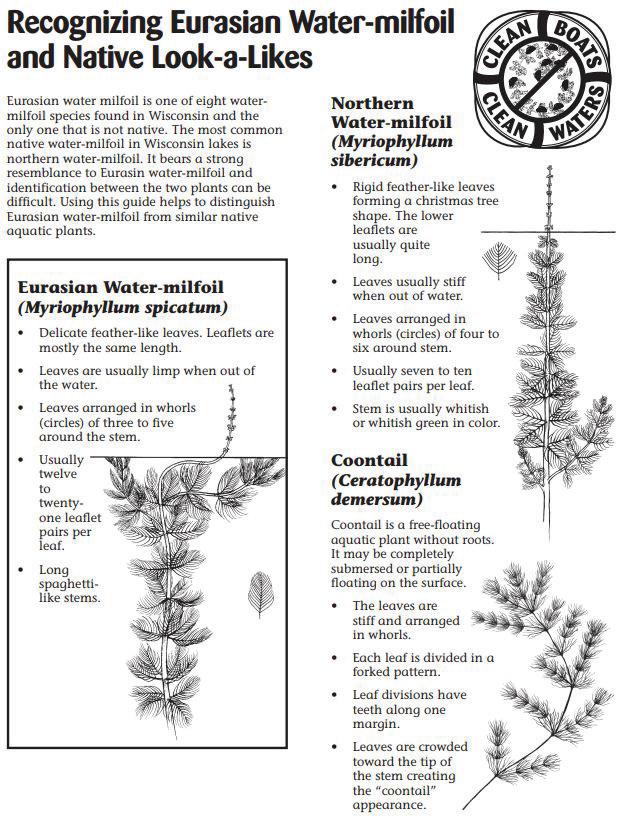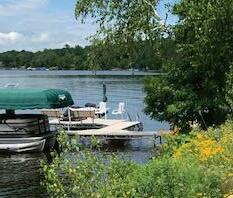
16 minute read
LETTER FROM THE CHAIRMAN
Letter from the Chair by BUD ERICKSEN
As I write this, I look at my calendar and see that we are well into the Spring season; however, Spring got a late start this year . On Tuesday, April 19 we saw three four wheelers out ice fishing . They cruised the lake with no concern of soft spots and appeared to be having fun . But high winds and milder temperatures finally conspired to clear the lake of ice on April 23rd or 24th, right about the average ice-out date . April was colder than normal though, putting some chores a few weeks behind schedule .
Advertisement
The Board has been busy throughout the winter preparing for DNR approvals on the Boat Landing, the Boat Cleaning Station, and the treatment of Eurasian Water Milfoil recently found near the existing boat landing . As this has been one of the busiest offseasons for the Board, the projects have been divided and directed by various Board Members . Following is the status of these major efforts .
THE BOAT CLEANING STATION:
The Boat Cleaning Station activities have been directed by Doug Ebeling . He has stayed on top of the process from North Carolina . He has an article and some pictures under a separate article in this Loon Lines . Doug has done a wonderful job and has the equipment ordered for an early Spring delivery .
THE WATERMILFOIL RAPID RESPONSE:
Jim Benike has been in charge of the Milfoil Rapid Response submittal to the Wisconsin DNR . Jim has been working with Margaret Rattei, a Senior Biologist with Barr Engineering of Minneapolis . Jim and Margaret have spent serious time in developing our submittal to the Wisconsin DNR Rapid Response Grant . The early treatment methods will require a chemical application that will hopefully eradicate the areas of concentration of the Eurasian Milfoil . The DNR has cautioned us, though, that it will be highly unlikely for a single treatment to result in total eradication; therefore, we are also preparing a long-term Aquatic Plant Management Plan to be approved by the Wisconsin DNR for the continuation of treatments going forward . Jim has written an article which appears elsewhere within this Loon Lines . Jim has worked very hard to develop the program as now submitted to the Wisconsin DNR and will continue to lead our efforts this summer .
BOAT LANDING:
The Boat Landing design documents were submitted to the Wisconsin DNR on November 1st . The design documents were prepared by Cedar Corporation of Menomonie Wisconsin . We anticipated an answer from the DNR at year’s end . However, with COVID continuation the DNR was unable to meet and evaluate the submittals until April 12th at which time our submittal of $160,786 .00 was approved . The approved value includes all the fees and is divided amongst the three cost-sharing partners: the City of Milltown, Milltown Township, and the Half Moon Lake Protection and Rehabilitation District . Our share of the costs is $26,797 .72 . This is below the maximum limit of $30,000 .00 which was approved at our Annual Meeting last summer .
While the approval of the DNR grant is great news, we now have to bid the documents, hire a contractor and determine the construction schedule . The schedule will probably require a midsummer or late-summer start . Construction will require building a cofferdam and dewatering prior to placement of the concrete slab . The slab will then require nearly 28 days to cure and reach its required strength prior to driving cars and trailers over the slab . The Board, in conjunction with the City of Milltown, the Milltown Township and our Board will develop a timeline for construction and an alternate landing area during the construction process . You will be notified as soon as the schedule is completed .
The addition of the Boat Cleaning Station, the construction of the Boat Landing and the treatment of the Eurasian Milfoil will require attention and understanding from all of us . We will be notifying all of you as we develop the various schedules, and if they cause any limitation on activities in any area of Half Moon Lake . There will be a lot of activity on the lake this summer; we will appreciate your understanding of and cooperation with any inconvenience .
We all look forward to a great summer on Half Moon Lake and hope we all return in good health .
Thank you,
Bud Ericksen, Chairman of the Board

“The Lake LIfe”. 20” x 16” oil on gesso board by Sarah Butler Sumner, daughter of Mary Martha and David Butler.
HALF MOON LAKE PROTECTION & REHABILITATION DISTRICT COMMISSIONERS & OTHER RESOURCES
Bud Ericksen, Chair Cell: 612-812-7838 bsericksen@comcast.net
Ellen Butler, Treasurer Cell: 612-964-1024 ellenbutler1912@gmailcom
Robert Cutshall, Secretary 612-360-3239 cutshallrj@icloud.com
Jim Benike, Board Member 507-254-1063 jimb@benike.com
Doug Ebeling, Board Member 612-964-4653 dougsgolfcars@gmail.com
Dave Balestri, Newsletter Editor Cell: 612-770-6153 halfmoonlakeloonlines@gmail.com
Dan Leh, Clean Boats Committee Cell: 612-490-1002 halfmoonlake@hotmail.com
Chris Nelson Polk County Board of Supervisors 715-557-0169 christopher.nelson@co.polk.us
Mike Dau, Milltown Chair 715-857-5203 email: hdau@lakeland.ws
Sally Klevgard, Newsletter Publisher Address: 131 Birch St. E., Amery Phone: 715-268-5800 paperworx@amerytel.net
Where in the World?
The Aker/Surdyk family visited the Outer Banks of North Caroline last October. Left to right: Carol, Scott, Matt, Cooper, Sara (Aker) Surdyk, Dan Suryk, Carter, and Megan. Sara and Dan were married in August.
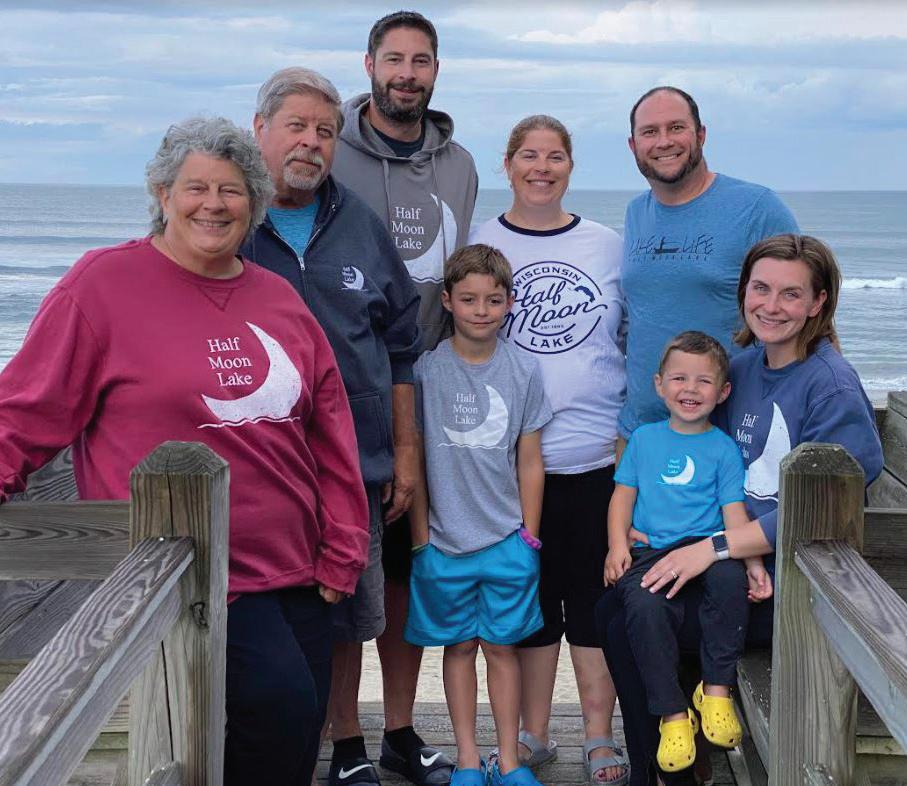



Clean Boats Clean Waters
The 2021 Clean Boats/Clean Waters season is in full swing. Our inspectors Boat Cleaning Station have been maintaining the landing since ice out and will continue until Labor Day. If you wonder what their role is at the launch it is simple…to prevent The DNR approved our grant request for a boat cleaning station at the Aquatic Invasive Species from entering Half Moon Lake. public launch. The station uses a waterless cleaning system that is charged by an off-grid, 450 watt solar array that charges the battery that It's everyone’s job to help prevent the spread of Aquatic Invasiveruns the unit. The battery should handle up to 85 boats per day. The Species. Whether you are a boater, angler or paddler, you have an important role to play vacuum tank is emptied by the satellite portable toilet vendor after about in keeping Half Moon Lake free of Aquatic Invasive Species. The main way Aquatic Invasive Species like zebra mussels and Eurasian Watermilfoil spread to new waters is by hitching a ride on the boats and trailers of visitors. 400 uses. The whole system is connected to the internet so that its usage can be monitored remotely. The software also includes an automatic tamper alert system. The station will be installed in late May to early June. The total cost is $35,420 of which of the grant will cover $19,193. The boat cleaning station will help keep our lake clean and lessen the risk of introducing more invasive species. Please take advantage of this free system and encourage your friends to PLEASE clean their boats before launching. As you know we have high boat traffic therefore this is especially important. We strive to keep Half Moon Lake pristine.
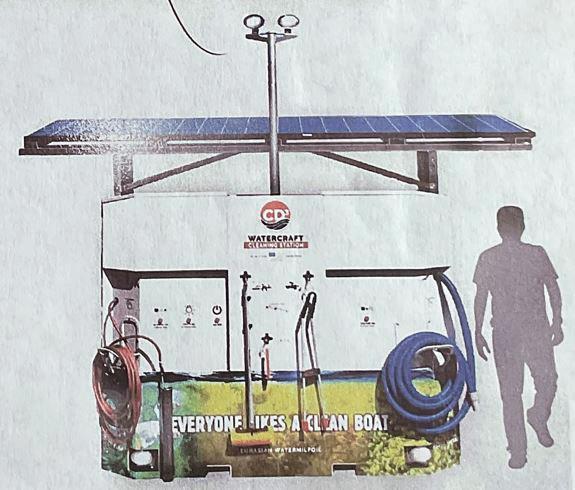
by Doug Ebeling
Water Quality Update:

The Half Moon Lake Conservancy has recently completed a high level study that will help us prioritize important land areas to focus on within the watershed in our efforts to protect the lake from harmful substances entering it. The study was performed by Barr To learn more information check out the University of Wisconsin-Extension Engineering. Copies of Barr’s summary memorandum, assessment maps of the watershed and a recording of Barr’s presentation to website: www.uwsp.edu/cnr/uwexlakes/. the Conservancy board are available on the HML website. While it isn’t the only substance that can be problematic in a lake, phosphorous is the one that generally causes the most harm. High phosphorous levels can cause increased growth of algae and large aquatic plants, which can result in decreased levels of dissolved oxygen - a process call eutrophication. High levels of phosphorous can also lead to algae blooms that produce algal toxins which can be harmful to human and animal health. At that point, the lake loses most of its recreational appeal and value as wildlife habitat. The good news is that the current phosphorous levels in HML are very low (20 ppb). This is one of the reasons that the lake is so pristine. Surface water coming into the lake currently has phosphorous levels ranging from 190 to 310 ppb. These levels are not problematic at this time. The focus of the Conservancy is the future. Changes in land use within the watershed could potentially have a negative impact on water quality. The Conservancy’s goal is to monitor any changes and work with local land owners in a cooperative manner to minimize or avoid any harm to the lake. We also will look for opportunities to improve the quality of water entering the lake. Both of these objectives can be accomplished in a number of ways: establishment of conservation easements, construction of or restoration of wetlands, construction of rain gardens or other facilities that remove harmful substances from surface water runoff, construction of shoreline buffers or by purchasing property and leaving it in its natural state. As noted above, the news for now is very good. We hope to keep the lake healthy and pristine in the coming years and appreciate the lake community’s support of our work.
You can also help this year by educating your family, guests and neighbors on the importance of stopping Aquatic Hitchhikers. Dan Leh CBCW Volunteer 612-490-1002 halfmoonlake@hotmail.com
Aquatic Invasive Species by Dan Leh History Corner By David J. Butler
I have been asked to educate our Lake District on what we do each day at the The 2021 Clean Boats/Clean Waters season is in full swing. Our inspectors have been maintaining the landing since ice out and will continue until Labor boat landing from Memorial Day through Labor Day. Since 2004 when the CBCW program was initiated, hundreds of workshops have been held and thousands of people in over fifty counties have been trained as watercraft Day. If you wonder what their role is at the launch inspectors. Lake residents, county board members, tribal community members, it is simple…to prevent Aquatic Invasive Species from entering Half Moon Lake. representatives from county park and forest programs, boat marina operators and realtors have attended the workshops to learn how aquatic invasive species It's everyone’s job to help prevent the spread of Aquatic (AIS) threaten Wisconsin waters. They also received instructions on how to organize a watercraft inspection program, how to approach boaters, perform Invasive Species. Whether you are a boater, angler or paddler, you have an important role to play boat/trailer checks, record pertinent data and report suspect specimens. in keeping Half Moon Lake free of Aquatic Invasive Species. The main way Aquatic Invasive Species like zebra mussels and Eurasian Watermilfoil spread to With the guidance of a CBCW handbook and a resource kit full of aquatic invasive species information, trained inspectors are the frontline defense against new waters is by hitching a ride on the boats and trailerAIS. On Weekdays, weekends and busy holidays, teams of watercraft inspectors s of visitors. across the state educate boaters on how and where AIS are most likely to hitch a ride and how to perform a watercraft inspection. During watercraft inspections, inspectors engage boaters in conversation about the AIS prevention steps and keep a record of how many people they talk with. They report this information to a statewide database that tabulates both paid and volunteer watercraft inspector data. Our Half Moon Lake Protection and Rehabilitation District currently has no volunteers, so we pay our inspectors 7 days a week from 8-10 hours a day based on boat traffic. On some holidays, like 4th of July, we may employ two inspectors. The primary goal is to stop any boat from launching prior to cleaning off vegetation from the boat and trailer. It is our first line of defense against unwanted aquatic invasive species.
Dan Leh
Welcome to Spring 2022 on Half Moon Lake!!!!! Eurasion Milfoil Update by Jim Benike, Board Member Eurasian Water Milfoil (EWM) was discovered by Polk county water specialists on October 6,2021. Members of the Lake District met with Polk County on October 11 to plan a strategy to eliminate the EWM. We hired Barr Engineering to lead us through the permitting and treatment process. The lake was surveyed for EWM and eight locations totaling 10 acres were found primarily near the boat landing but one location was mid-lake near the East shore. The depths ranged from 3-13 feet deep. This spring we will resurvey the lake for EWM. When the lake temperature averages 60 degrees a licensed aquatic contractor will treat the areas with ProcellaCOR (Florpyrauxifen-benzaldehyl) which is noted for not harming native plants and for dispersing quickly. There will be public notices as required by the DNR. We will conduct a post-treatment survey in late-June to monitor our results. If individual plants are found, we will probably have to hand pull them. Assuming we will not be 100% successful, we are preparing now for 2023. We will need to have a formal aquatic plant management plan for 2023 which will be coordinated with Polk county, the DNR, and Barr Engineering. A management plan is required to receive future DNR grants. We expect to have more information at the annual meeting which will be post-treatment. We are considering offering through Polk County an Eurasian Water-Milfoil vs Northern Water-Milfoil identification class to help people learn how to identify and dispose of EWM.
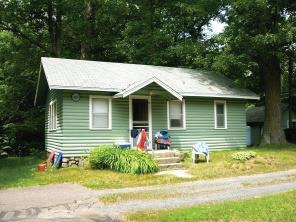
Should the new dam raise the lake level of Half Moon Lake or lower the lake level? In 1928, that was the burning question being argued by people with varying interests around the lake. The Commissioner from the Wisconsin Public Service Commission, who was presiding at a hearing on the issue, told the crowd, “The level will not be raised beyond the normal level of the lake. The normal level will be determined by looking at the varying levels over the last 20 years.” He then asked the crowd for comments as to what the lake level had been. The HOW CAN YOU HELP? answers were affected by the level of the lake they preferred. Charley Johnson fed cattle along-side Harder Creek north of the lake before the beavers built their dams, so he wanted a low level that would not cause his land to be flooded. There were five resorts around the INSPECT your boat, trailer, and equipment and lake and the owners preferred a higher lake level to make better swimming beaches. Mads Bank, the owner of the electric power plant on Balsam Lake, wanted a lower dam in order to keep a constant flow of water coming down the steam to his plant. The Township trustees REMOVE visible aquatic plants, animals, and mud were worried a higher level would wash out the new road they were building around the south end of the lake. before leaving the water access. The Commissioner ended the meeting by saying he would send out a surveyor to get an answer. The order came out saying the dam will DRAIN water from your boat, motor, bilge, live wells, be built at an elevation of 97.80 feet. The dam was built. Later it was found the builders had made a mistake and built the dam with an and bait containers before leaving the water access. elevation of 98.50 feet. A supplemental order was entered saying “it appears there has been no damage caused by the higher level, so the dam will remain at 98.50 feet”. REPORT new sightings. More details and photos of the old dam can be found in The History of Half Moon Lake, a Story of Trust, written in 2013. DISPOSE of unwanted bait and other animals or aquatic plants in the trash. SPRAY, RINSE, or DRY boats and recreational equipment to remove or kill species that were not visible when leaving a waterbody. See you on the water! For those of you new to Half Moon Lake and unfamiliar with loon behavior a brief account of what to expect during the summer months follows. Adult loons migrate every September mainly to the Gulf of Mexico and return in the spring upon ice out. Generally, the loons are monogamous and return every year to their same territorial lakes. We have been fortunate over the years to usually have two pairs on Half Moon Lake. On April 20th of this year, as the ice was out, our first pair of loons arrived on the north end of the lake and by early May a second pair was spotted on the south end. Male and female loons work together to build a nest of dead plant material in May or early June. Nesting sites are usually on weedy shorelines or small boggy islands near the shore. Loons usually lay two eggs and take turns incubating them. During this time, it’s vital that people stay at least 200’ away from nesting sites as causing the adult to leave the nest makes the eggs vulnerable to predators such as eagles, raccoons, and snapping turtles. If you see a loon lying flat on a nest with its head down, please distance yourselves. HALF MOON LAKE Chicks hatch within 25-28 days and immediately take to the water. From birth, loon chicks can swim but their first week RESORT they may spend half their time riding on their parents backs for protection and warmth. The parents feed them for the Seasonal, housekeeping cabins first eight weeks of life. They are also able to dive soon after hatching but have difficulty staying submerged and tend to pop up like corks. Thus, it is imperative that while boating, we vigilantly look out for these newly hatched babies. INDOOR STORAGE AVAILABLE! Boats – Pontoons - Cars Loons are protected by State and Federal laws as migratory, 715.825.3737 1261 County Rd. G nongame birds. Harassing protected loons can carry a fine of halfmoonresort.weebly.com Milltown, WI 54858
The Spring 2022 Loon Report $1000 and 90 days in jail. If you see someone harassing one of our loons, please attempt to educate the offender, and if necessary, call the DNR or the nearest U.S. Fish and Wildlife Service Law Enforcement Office. We can all help protect our loons by using nonlead fishing tackle, participating in the WI DNR’S monofilament recycling program, following the 200’ rule, and especially during nesting season by controlling our boat speeds in nesting areas to prevent wakes that can wash out nests. We are so fortunate to have two pairs of loons on our lake, please help to protect them so we can all enjoy their eerie calls and beauty during the summer months. If you have any questions about loons or loon behaviors you observe, please feel free to e-mail me at tmechelke@gmail.com. Have a great summer! Pat Mechelke – Half Moon Lake Loon Ranger
